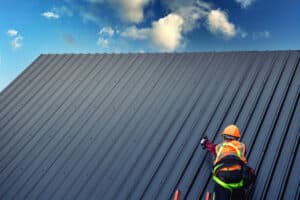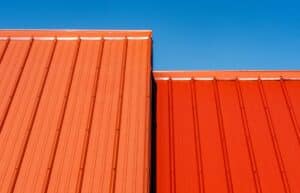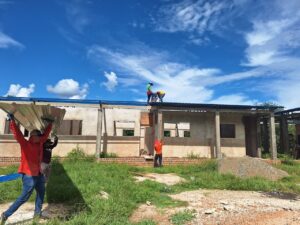Winter can be rough on metal roofs, leaving behind signs of wear and tear that need attention. From rust patches to loose screws, the cold weather can wreak havoc if these issues are ignored. A little maintenance now can save a lot of trouble in the long run.
It’s important to know how to spot the damage early and have the right tools and materials on hand. Fixing these problems right away not only helps your roof last longer but also protects your home from leaks and structural damage. Regular checks and timely repairs are key to keeping your roof in top condition.
Taking steps to prevent future damage is just as important as fixing current issues. Whether it’s installing protective guards or ensuring proper ventilation, these proactive measures help your metal roof withstand future winter challenges. By staying ahead of potential problems, you maintain both the roof’s strength and its appearance.
1. Identifying Common Winter Damage on Metal Roofs
Spotting Rust and Corrosion
During winter, metal roofs can suffer from rust and corrosion due to constant exposure to moisture and varying temperatures. Look for areas where rust appears, typically showing up as reddish-brown spots on metal surfaces. Corrosion often occurs around seams and fasteners if water accumulates or if protective coatings are compromised. Regular inspections help you catch these early signs before they become significant problems, protecting the structural integrity of your roof.
Detecting Loose or Missing Fasteners
Winter weather can cause fasteners on metal roofs to loosen or even go missing due to constant expansion and contraction. These fasteners secure metal panels, and if they’re not intact, it can lead to gaps that let in water and cause leaks. Examine your roof for signs of shifting panels or visible gaps, indicating possible fastener issues. You might need to tighten them or replace any that are missing to ensure your roof stays tightly sealed.
Recognizing Paint Peeling and Fading
Paint on metal roofs serves both protective and aesthetic functions. However, harsh winter conditions can make paint peel or fade. Pay attention to areas where the paint is flaking or has lost its color, as this can expose the metal underneath to rust. Keep an eye out for any bubbling or cracking along the painted surfaces, and plan to repaint these sections to maintain both the appearance and protection of your roof.
2. Essential Tools and Materials for Metal Roof Repair
List of Necessary Tools
Repairing your metal roof properly requires having the right tools on hand. Here’s a helpful list of what you might need:
– Safety harness and gloves: For safe working conditions.
– Metal snips: To cut and trim metal if needed.
– Cordless drill and screwdriver: For fastening screws and bolts.
– Wire brush: To remove rust and prepare surfaces.
– Measuring tape: For precise measurements and cutting.
Recommended Repair Materials
Using appropriate materials ensures your repairs will be long-lasting. Consider these materials when fixing your metal roof:
– Metal screws and fasteners: Suitable for metal roofing.
– Rust-resistant primer and paint: Protects against corrosion and improves aesthetics.
– Metal panels or patch kits: For replacing damaged sections.
– Sealant or roofing cement: To secure seams and fasteners, keeping water out.
– Rust converter: Helps treat existing rust before applying new coatings.
Having the right tools and materials makes a metal roof repair job quicker and more effective. Take the time to choose high-quality items to ensure your roof remains strong and protected against future winter challenges.
3. Step-by-Step Repair Process for Winter Damage
Cleaning and Preparing the Roof Surface
Start by thoroughly cleaning your metal roof to remove dirt, debris, and old paint flakes that might interfere with repairs. Use a wire brush to scrub away rust and other loose materials. It’s important to have a clean surface to ensure that repairs and coatings adhere properly. For stubborn dirt, consider using a mild detergent and water to wash the affected areas. Allow the roof to dry completely before moving on to make sure that the sealants and coatings can set correctly.
Fixing Fasteners and Seals
Next, check all the fasteners and seals on your roof. Tighten any loose screws and replace missing ones with new fasteners that are appropriate for metal roofing. Pay special attention to the seams and joints, applying roofing sealant where needed to ensure a watertight seal. It’s crucial to seal these areas effectively to prevent any future water leaks and keep your metal roof secure during harsh weather conditions.
Treating Rust and Applying Protective Coatings
If rust is present, treat it with a rust converter to stop it from spreading. This will also prepare the surface for a protective coating. Once treated, apply a rust-resistant primer followed by a fresh coat of paint specifically designed for metal surfaces. This coating process will protect your roof from future corrosion and enhance its appearance. Ensure even application to maximize the protection offered by these coatings against future winter damage.
4. Preventing Future Winter Damage
Regular Inspection and Maintenance Tips
Preventing winter damage starts with regular roof inspections. Perform checks at least twice a year and after major storms to spot any potential issues early. Look for loose or missing fasteners, rust, and any signs of water intrusion. Addressing these problems promptly can prevent bigger, more costly repairs down the line. Consistent maintenance ensures your roof remains in good condition through the winter months.
Installing Snow Guards and Drip Edges
Snow guards and drip edges are valuable additions to your metal roof. Snow guards help manage snow accumulation, reducing the risk of snow slides that can damage structures and landscaping. Drip edges guide water away from the roof, protecting the underlying materials from water damage. Installing these features can greatly reduce the impact of harsh winter weather and help prolong the life of your roof.
Ensuring Proper Roof Ventilation
Proper roof ventilation is another critical factor in preventing winter damage. Adequate ventilation helps regulate the temperature in your attic, minimizing the risk of ice dams. Make sure that vents are clear and functioning well to allow air to circulate. Ensuring your roof’s ventilation system is efficient protects against moisture build-up and helps maintain the overall integrity of your metal roof.
Conclusion
Metal roofs in Florida face unique challenges during winter, but taking proactive steps can keep them in good shape. Regular inspections, proper maintenance, and following a detailed repair process can protect your roof from damage. Implementing useful additions like snow guards and ensuring proper ventilation can further safeguard your roof against future weather conditions.
When it comes to winterizing your Orlando metal roof, trust Stratus Roofing to provide expert advice and services. Our team is ready to help you prep your roof for winter, ensuring it stands strong and lasts for years to come. Reach out to us today to learn more about our comprehensive roofing solutions for your home.







